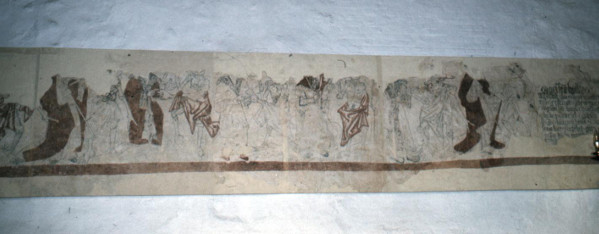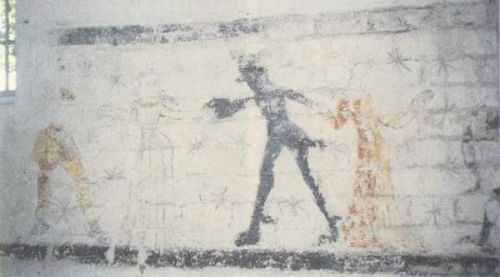Denmark Dance of Death |

Version française |
|
Copyright (textes) |
Denmark prides itself on two dances of death. The first (and oldest) one is found in the city of Egtved; unfortunately, it is in bad condition. The second one, very well preserved, was painted in Nørre Alslev. Some specialists consider another work, the Jungshoved fresco, to be a Danish dance of death; however, a thorough analysis leads us to believe that this painting belongs to a different genre. Nørre Alslev Egtved 
With its 21 characters - ten dead, ten living and one unknown figure - this dance of death is the most important one in Scandinavia. However, due to its state of decay, we can't figure out the social class of all dancers. Unlike most dances of death, this one must be read from right to left. It begins with a prologue. In this first picture Christ, who is covered with wounds (and beheaded like every other figure), stands up beside a chalice. This reminds us of a vision the pope Gregory IV once had: he saw the Lord bleeding, and the blood that poured from His body was caught in a precious vessel. The prayer that goes with this painting tells of the sufferings the Christ endured to save us all. The actual dance of death then begins with a skeleton taking the pope away, then the emperor, or king, and the cardinal. The seven figures that follow can't be identified with certainty. The last character could be a skeleton. But since his foot differs from all others, it is also possible that he be a preacher; although this figure usually appears at the beginning of the dance, not at the end. Jungshoved 
From left to right (click here for a clearer picture), we can see the almost totally erased silhouette of a knight, followed by a young girl, a devil, another girl and another knight, also very hard to distinguish. The first damsel walks arm in arm with the knight and the devil; she will soon succumb to temptation. The second damsel already wears as crown. The devil holds her hand, while the knight turns his back on her; she took the presents and yielded to the forces of evil. Whatever the nature of the Jungshoved fresco, I don't believe it belongs to the genre of the dance of death. The central figure, in black, looks much more like a devil than like a corpse. If you look closely, you will notice he has a tail and spurs! As for the living, they are only four, each of them from the nobility. No clergyman, no burgher, no poor: this is very surprising indeed for a dance of death, whose most important tradition was to show people from different social classes. Furthermore, two of the four dancers are women. Now, except for the Women's Dance of Death by Guyot Marchand (a feminine version of a medieval best-seller, essentially published to make money), all dances of death show a majority of masculine figures. Those pictures of Denmark dances of death are from Axel Bolvig and Martin Hagstrøm. Mr. Bolvig has recorded all the frescoes to be found in Danish churches. To visit his site, click here. Mr Hagstrøm translated into Danish this part of my website and scanned some images. Click here to read about danishe's dance of death on his website.
|